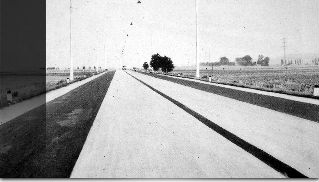 To most Americans, the word “Autobahn” conjures up images of infinite stretches of European roadway without any sort of speed limit, a place where supercars are legally allowed to zip past ordinary vehicles at any speed they wish. To the average German, the image is less exotic. The Autobahn, or Bundesautobahn as it’s known in Germany, is simply a federal highway system. Most German drivers consider it just a road, kind of like the U.S. Interstate System but with one important difference, no speed limit!
To most Americans, the word “Autobahn” conjures up images of infinite stretches of European roadway without any sort of speed limit, a place where supercars are legally allowed to zip past ordinary vehicles at any speed they wish. To the average German, the image is less exotic. The Autobahn, or Bundesautobahn as it’s known in Germany, is simply a federal highway system. Most German drivers consider it just a road, kind of like the U.S. Interstate System but with one important difference, no speed limit!
Origin of the Autobahn
On August 6, 1932, the first German “automobile road” was opened between Bonn and Cologne. It was strictly for the use of cars, trucks and motorcycles and it had no cross streets. Slower vehicles like horse-drawn carts were banned from using it. This was the beginning.
By the late 1930s the Nazi Party began taking over the Germany’s political system and Adolph Hitler rose to power. Because his military campaigns needed a highly developed road system to move war materials, he began an aggressive road building campaign across Germany. These roads became the first high-speed, limited-access roads in the world at the time.
Today
Not all of the Autobahn allows unlimited speed. Only certain sections do, but when driving on those sections you are allowed to drive as fast as you would like.
As on other highways, the autobahn does have a posted minimum speed -37 miles per hour. This prohibits the use of mopeds, bicycles, smaller cars and other, slower forms of transport on the roads -including a still-standing ban on horse-drawn vehicles.
Similar autobahns are established in Switzerland, Austria, Spain and Portugal. Like the German Autobahn, these systems were designed to be an efficient transportation network to spur commercial development and allow for military transport in times of national emergency. Speed is just a byproduct rather than an end -though Germans do admit a certain pride in the association between fast cars and their highway system.
The Autobahnpolizei
Similar to the United States, Germany’s autobahn is regulated and laws are enforced by a specialty branch of the federal police, the Autobahnpolizei. The German autobahn police rely heavily on advanced technology, including video surveillance, radar and other techniques.
Some of the more interesting laws involving the Autobahn are:
- The two-second rule — leaving at least two seconds of reaction time between you and the car in front — can result in the suspension of a driver’s license for up to three months.
- Tires must be rated for a vehicle’s top speed. There are allowances in the case of winter tires but the driver must display a window sticker advising police they are cleared to use those specific tires.
- The right lane must be used for travel, and the left lane for passing. This is strictly enforced.
- Emergency lanes are for emergencies only. Even running out of gas isn’t an excuse as this is an avoidable circumstance.
The Future
There is some discussion over imposing an 80 miles per hour speed limit on the Autobahn but the limit has less to do with safety and more to do with concerns over vehicle emissions. It’s a simple formula: a vehicle’s fuel consumption, and its emissions, increase with speed. However, in 2007, German Chancellor Angela Merkel was reported as saying she would not support any measure to limit speeds on the nation’s highway system. Saying a traffic jam was at least as environmentally damaging as high-speed driving, she called on automakers to increase fuel efficiency and reduce emissions instead. Merkel’s opposition serves to illustrate the German love affair with cars and a nation refuses to relinquish its right to speed.
Yet the tide may be shifting. Autobahns in Austria and Switzerland have implemented speed limits where once they were free from restrictions. Germany may, in time, be one of the last of the developed countries without speed restrictions.